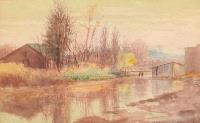
Richard Goodwin
Born in 1840 in Albany, New York, Richard Goodwin began his painting career as a portrait painter but turned to still lifes, probably influenced by the highly realistic style of William Harnett. His work is distinctive for his many subjects that are cabin doors, likely over 100, decorated with hunting and other outdoor equipment. All of them were very large and completed after 1886 when William Harnett introduced trompe l'oeil painting in New York with After the Hunt that got much public attention.
Of his career, Alfred Rubenstein wrote in After the Hunt: "He painted portraits for a living and landscapes for love, but above all he delighted in the hunter's cabin door."
An idea for one of his cabin door paintings came about in 1905 when he was in Portland, Oregon and attended the one-hundredth anniversary fair to commemorate the Lewis and Clark Expedition. He saw the exhibit of the door of a cabin where Theodore Roosevelt had lived when he was ranching in the Dakotas in 1890. Goodwin used it as a model for his painting, Theodore Roosevelt's Cabin Door.
Goodwin was the son of portrait painter, Edwin Wyburn Goodwin, who died when his son was five years old. He studied in New York with obscure teachers. Wounded at the Battle of Bull Run during the Civil War, he spent the next twenty years as an itinerant painter in western New York State. In the 1880s, he lived in Syracuse from where he began his still lifes.
After 1890, he lived in Washington D.C. where he sold eight canvases to Senator Leland Stanford and several to Senator George Hearst. He then went to Chicago in 1893 for the World's Fair and remained seven years, after which he went to Colorado Springs, 1900-1902, and then Los Angeles and San Francisco where he lost four years of work in the 1906 fire. He also went to the Pacific Northwest.
During his lifetime, little was written about him except his death notice in ARTnews, December 17, 1910.